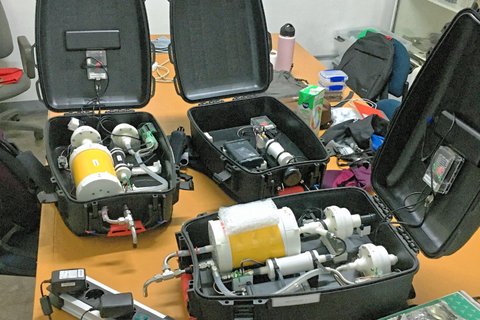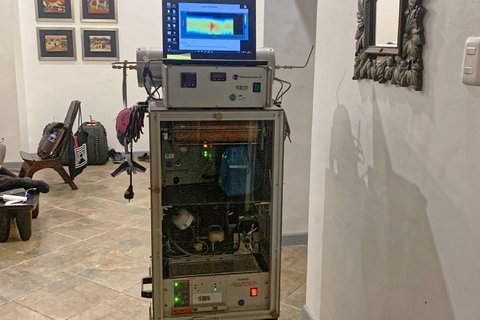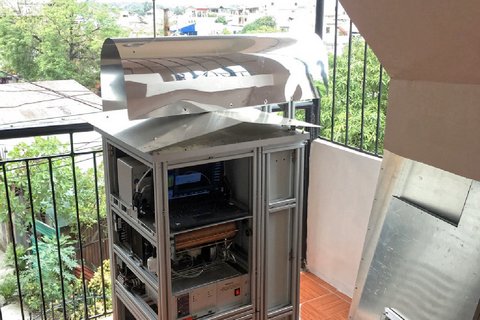EVIDENCE DRIVEN INDOOR AIR QUALITY IMPROVEMENT (EDIAQI)
People are constantly exposed to air pollution. And not only outdoors, but also indoors. The importance of indoor spaces is increasing as more and more time is spent indoors. Recent studies show that people in industrialised countries spend up to 90 percent of their time indoors, almost 70 percent of which is spent at home. Recently, the amount of time spent indoors has increased dramatically due to the global pandemic. While this isolation can prevent the spread of viruses, poor air quality indoors can have other serious health consequences. Recent studies suggest that up to 15 per cent of COVID-19-related deaths could be attributed to poor indoor air quality. Poor indoor air quality along with biological contamination and humidity would increase the risk of respiratory disease by 50 per cent. A 2020 systematic review and meta-analysis found that in 2017, household air pollution was associated with 1.8 million deaths and more than 60 million reduced life years worldwide. Most of the burden associated with household air pollution is in low- and middle-income countries (1). In Europe alone, exposure to particulate matter (PM) shortens the life expectancy of each person by an average of almost one year, mainly due to the increased risk of cardiovascular and respiratory diseases, neurological disorders and lung cancer.
Although poor indoor air is a major health risk, it affects people differently and certain population groups are particularly at risk: children, the elderly and people with respiratory diseases are more sensitive to these environmental risks than the general population. Indoor air quality is determined by various factors and processes, such as outdoor pollution levels, pollutant transport between indoor and outdoor areas, indoor emissions, chemical reactions of gases on particles and surfaces, dynamic processes (e.g. resuspension, deposition, evaporation, growth, coagulation, etc.) and ventilation/ indoor air filtration (2). Outdoor contaminants can enter indoor spaces through leaky doors and windows, for example. Indoor air chemistry is another process that contributes significantly to indoor air quality. Despite extensive research on indoor air quality in the past, there is still a knowledge gap about the sources of pollution, the relationship between indoor and outdoor air, and ventilation/infiltration rates. Few studies have measured ultrafine black soot particles, submicron particles and allergens in relation to sensitive groups (e.g. children, pregnant women) with high time resolution. In addition, ventilation rates and deposition rates vary greatly (up to 30 % from the average) between different residential buildings and experimental periods (e.g. summer and winter). Differences in the ventilation habits of the occupants, different material surfaces, meteorological conditions, etc. mean that stationary and static studies of indoor air quality provide only limited useful results (3). There is a lack of representative data on exposure to particles, gases and allergens in residential buildings, as well as risk assessments and legislation on long-term indoor air quality for different types of indoor spaces in Europe.
An analysis of existing indoor air quality guidelines in EU Member States found that reference values for indoor pollutants differ significantly across Europe. Such differences can lead to social polarisation and different living conditions (4). In order to avoid imbalance and protect those most at risk, it is important to establish guidelines for monitoring indoor air quality and to conduct long-term and area-wide measurements to collect the most relevant data on indoor air pollution. The legal regulations of most countries to control air pollution still only refer to particulate matter of the size classes PM10 and PM2.5 (aerodynamic particle diameter <10 and <2.5 μm, respectively). However, scientific evidence shows the importance of the chemical composition of the smaller particle fractions such as PM1 and soot. Some toxicological studies suggest that the PM1 particle fraction is more hazardous than PM2.5 in terms of cytotoxic effects and inflammation (5). Furthermore, science-based evidence on indoor and outdoor air suggests that the use of PM10-bound benzo(a)pyrene as the sole marker of exposure to carcinogenic polycyclic aromatic hydrocarbons (PAHs), needs to be complemented by the inclusion of other health-relevant PAHs, gaseous PAHs (e.g. naphthalene) and smaller PM fractions (6). Particular attention must also be paid to better understanding exposure to other and novel compounds that are not yet listed in the regulations but are considered hazardous to human health. For example, exposure to ultrafine particles and black carbon is known to have particularly adverse health effects due to their small size (ability to penetrate the air-blood barrier in the respiratory tract) and chemical composition. Determining the size distribution of particle-bound carcinogenic compounds, the exposure dose of soot and ultrafine particles, and the physicochemical properties of some emerging pollutants such as microplastics and plasticisers would allow the exposure dose of pollutants in the respiratory tract to be estimated and thus provide a much more accurate assessment of health risks (7,8,9).
Within the EDIAQI project, several indoor exposure scenarios for standard air pollutants and new emerging pollutants/contaminants are investigated. Residential areas (houses and public offices) and leisure facilities (e.g. cinemas, theatres, restaurants), hospitals and schools across Europe were selected as the study area. The differences between the subpopulations are investigated in different exposure concentrations and respiratory deposition doses of pollutants. For the quantification of indoor air pollutants, the latest aerosol instruments are used together with the latest innovative and technologically advanced low-cost sensors. The latter are thoroughly validated and calibrated to achieve the defined accuracy and precision of the reference instruments.
A unified, large-scale and long-term strategy for monitoring indoor air pollution, incorporating transdisciplinary research approaches, Big Data, interoperability and the Internet of Things, would enable:
(a) enable scientists to better understand indoor pollution levels and associated health effects;
b) provide science-based information for legislative bodies to set guidelines for indoor air quality; and
c) to develop strategies for sustainable, science-based technological innovations to improve indoor air quality.
References:
(1) K. K. Lee et al., Lancet Glob. Heal. 8, e1427–e1434 (2020). DOI: https://doi.org/10.1016/S2214-109X(20)30343-0
(2) C. He, L. Morawska, D. Gilbert, Atmos. Environ. 39, 3891–3899 (2005). DOI: 10.1016/j.atmosenv.2005.03.016
(3) C. C. Halios, C. G. Helmis, K. Eleftheriadis, H. A. Flocas, V. D. Assimakopoulos, Water. Air. Soil Pollut. 204, 333–350 (2009). DOI: 10.1007/s11270-009-0048-2
(4) G. Settimo, M. Manigrasso, P. Avino, Atmosphere (Basel). 11 (2020). DOI: 10.3390/atmos11040370.
(5) P. I. Jalava et al., Atmos. Environ. 120, 427–437 (2015). DOI: 10.1016/j.atmosenv.2015.08.089
(6) M. Oliveira, K. Slezakova, C. Delerue-Matos, M. C. Pereira,. Morais, Environ. Int. 124, 180–204 (2019). DOI: 10.1016/j.envint.2018.12.052
(7) J. Gasperi et al., Curr. Opin. Environ. Sci. Heal. 1, 1–5 (2018). DOI: 10.1016/j.coesh.2017.10.002
(8) R. Dris et al., Environ. Pollut. 221, 453–458 (2017). DOI: 10.1016/j.envpol.2016.12.013
(9) Z. Q et al., Environ. Sci. Technol. 54, 6530–6539 (2020). DOI: 10.1021/acs.est.0c00087
Project partner:
1 The Lisbon Council (Koordination) LC (BE) > https://lisboncouncil.net/
2 Know-Center KNOW (AT) > https://www.know-center.at/
3 Institute for Medical Research and Occupational Health IMROH (HR) > https://www.imi.hr/en/
4 Ascalia Ltd. ASC (UK) > https://ascalia.io/
5 WINGS ICT Solutions WINGS (GR) > https://www.wings-ict-solutions.eu/
6 REGION HOVEDSTADEN REGIONH (DK) > https://www.regionh.dk/
7 Leibniz Institute for Tropospheric Research TROPOS (DE) > https://www.tropos.de/
8 Institute for Anthropological Research ANT (HR) > https://inantro.hr/en/homepage-eng/
9 Technische Universitaet Graz TUG (AT) > https://www.tugraz.at/home
10 University of Molise UMOL (IT) > https://www.unimol.it/english/
11 Universidad de Sevilla USEV (ES) > https://www.us.es/
12 Thinnect THIN (EE) > https://thinnect.com/
13 Srebrnjak Children's Hospital SCH (HR) > https://www.bolnica-srebrnjak.hr/index.php/en/
14 Dedagroup Public Services DEDA (IT) > https://www.deda.group/deda/markets/public-services
15 Tallinn University of Technology TalTech (EE) > https://taltech.ee/en
16 Lab Service Analytica LAS (IT) > https://www.labservice.it/
17 State research institute Center for Physical Sciences and Technology FTMC (LT) > https://www.ftmc.lt/en
18 National Institute of Biology NIB (SI) > https://www.nib.si/eng/
Project duration: 01.12.2022 - 01.12.2026
Funded by: EU Commission Grant No-101057497-EDIAQI
Contacts:
Prof. Mira Pöhlker,
Head of the Department of Atmospheric Microphysics, Leibniz Institute for Tropospheric Research (TROPOS), Leipzig
Phone +49-341-2717-7445
https://www.tropos.de/institut/ueber-uns/mitarbeitende/mira-poehlker
and
Leizel Madueno,
Department of Atmospheric Microphysics, Leibniz Institute for Tropospheric Research (TROPOS), Leipzig
Phone +49 341 2717-7064
https://www.tropos.de/institut/ueber-uns/mitarbeitende/leizel-madueno
and
Dr. Liina Tõnisson,
Scientific Coordinator/Technology Transfer, Leibniz Institute for Tropospheric Research (TROPOS)
Phone +49 341 2717-7383
https://www.tropos.de/en/institute/about-us/employees/liina-tonisson
Further information and links:
TAME-BC - Clean Air for a Sustainable Future: A Transdisciplinary Research Approach to Black Carbon Emissions Reduction in Metro Manila, Philippines
https://www.tropos.de/en/research/projects-infrastructures-technology/transfer/wissenstransfer-tame-bc
Exposure to ultrafine aerosol particles in German homes depends primarily on the people themselves (Press release, 19.05.2020)
https://www.tropos.de/en/current-issues/press-releases/details/belastung-durch-ultrafeinstaub-in-deutschen-wohnungen-haengt-vor-allem-von-den-menschen-selber-ab
The WCCAP: Competence Centre for the Development and Application of Microphysical Aerosol Particle and Cloud Droplet Measurement Methods
https://www.tropos.de/en/research/projects-infrastructures-technology/technology-at-tropos/quality-assurance-of-aerosol-measurements/quality-assurance
TROPOS Long-term studies of regional importance and air quality
https://www.tropos.de/en/research/atmospheric-aerosols/long-term-trends-and-process-analysis#spc-130
Publications:
Madueño, L., Kecorius, S., Löndahl, J., Schnelle‑Kreis, J., Wiedensohler, A., Pöhlker, M.: A novel in-situ method to determine the respiratory tract deposition of carbonaceous particles reveals dangers of public commuting in highly polluted megacity. Part. Fibre Toxicol., 2022, 19, 61. (Published: 15 September 2022). https://doi.org/10.1186/s12989-022-00501-x
Tõnisson, L.; Voigtländer, J.; Weger, M.; Assmann, D.; Käthner, R.; Heinold, B.; Macke, A. Knowledge Transfer with Citizen Science: Luft-Leipzig Case Study. Sustainability 2021, 13, 7855. https://doi.org/10.3390/su13147855
Tõnisson, L.; Kunz, Y.; Kecorius, S.; Madueño, L.; Tamayo, E.G.; Casanova, D.M.; Zhao, Q.; Schikowski, T.; Hornidge, A.-K.; Wiedensohler, A.; Macke, A. From Transfer to Knowledge Co-Production: A Transdisciplinary Research Approach to Reduce Black Carbon Emissions in Metro Manila, Philippines. Sustainability 2020, 12, 10043. https://doi.org/10.3390/su122310043
Madueño L., Kecorius S., Löndahl J., Müller T., Pfeifer S., Haudek A., Mordoñez, V., Wiedensohler, A.: A new method to measure real‐world respiratory tract deposition of inhaled ambient black carbon. Environ Pollut. 2019;248:295–303. https://doi.org/10.1016/j.envpol.2019.02.021



